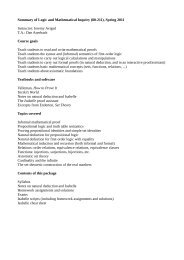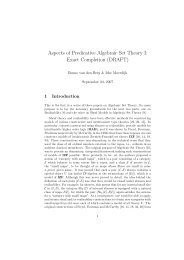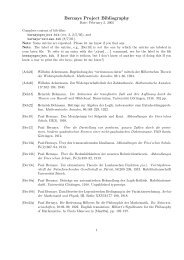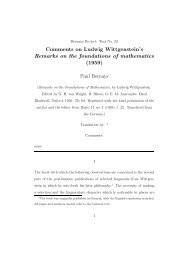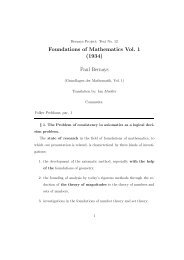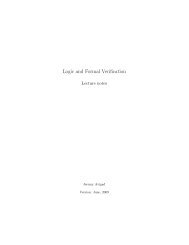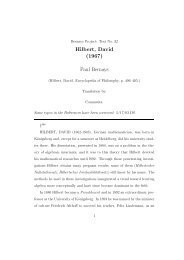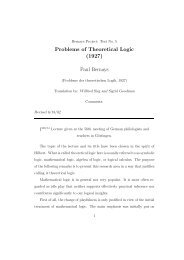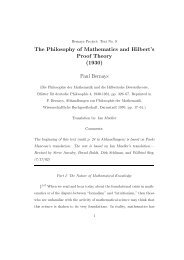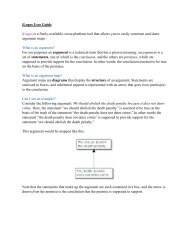FORMAL EPISTEMOLOGY: Some open topics, background - Phil Cmu
FORMAL EPISTEMOLOGY: Some open topics, background - Phil Cmu
FORMAL EPISTEMOLOGY: Some open topics, background - Phil Cmu
You also want an ePaper? Increase the reach of your titles
YUMPU automatically turns print PDFs into web optimized ePapers that Google loves.
<strong>FORMAL</strong> <strong>EPISTEMOLOGY</strong>:<br />
<strong>Some</strong> <strong>open</strong> <strong>topics</strong>, <strong>background</strong> and bibliography<br />
Horacio Arló Costa<br />
July 4, 2006<br />
1 Introduction<br />
I will divide the main <strong>open</strong> <strong>topics</strong> into four main sections: the first devoted to<br />
epistemic logic, the second to Bayesian epistemology, the third to models of belief<br />
change and the fourth to interactive epistemology and related issues in the area of<br />
rationality in general (especially its relationships with issues in rational choice).<br />
2 Epistemic Logic<br />
The issue of logical omniscience – should knowledge be closed under logical consequence,<br />
should agents know all tautologies, or be at least committed to know<br />
them, should knowledge be closed under conjunction, etc. – and the possibility<br />
of studying epistemic operators where logical omniscience can fail is still the object<br />
of a great deal of attention both by logicians and formal epistemologists in<br />
general.<br />
Another foundational topic that is very interesting is related to the role played<br />
by the domain of possibilia or the domain of states considered in the models.<br />
Should they be possible worlds as traditionally understood (un-structured<br />
primitives linguistically describable via maximal and consistent sets of sentences)<br />
or should they be understood as possibilia with epistemic parts (a la Lewis or<br />
Halpern) or should they be understood minimally as in the case of Hintikka’s<br />
model sets? The first topic and the second often interact in important ways.<br />
A third, relatively <strong>open</strong>, topic is the study of first and second order epistemic<br />
logics, in particular logics of probability. Quantification over individuals,<br />
over epistemic options or even worlds (in hybrid logics) are of special conceptual<br />
1
July 4, 2006<br />
<strong>FORMAL</strong> <strong>EPISTEMOLOGY</strong>: Lecture Notes<br />
interest. Rich models where various modalities and agents interact are also of<br />
particular philosophical interest.<br />
Finally the careful distinction between knowledge attributions and knowledge<br />
claims leads to interesting foundational issues of various degrees of depth and to<br />
interesting logical distinctions.<br />
Models of conditional belief or conditionals in general face some of the aforementioned<br />
challenges plus some foundational conundrums of their own (like doubts<br />
about whether, say, indicative conditionals are truth carriers at all).<br />
2.1 Logical Omniscience<br />
Logical omniscience can fail due either to normative or descriptive issues. Two<br />
examples of normative reasons are (a) models of high probability which fail rule<br />
(C) – see lecture notes – and (b) models of knowledge as tracking truth a la<br />
Nozick which fail at least rule (M) – see lecture notes and a recently distributed<br />
paper contributed to the last FEW meeting.<br />
But lack of logical omniscience can appear also due to computational limitations<br />
or, more in general, cognitive limitations. In this case there are various<br />
types of models of bounded agents in the literature. The very notion of bounded<br />
agent remains an <strong>open</strong> conceptual problem with no dominant model universally<br />
recognized in the literature.<br />
A general introduction to some of the dominant models (with some exceptions)<br />
is the relevant chapter in Reasoning About Knowledge, by Ronald Fagin,<br />
et al; MIT Press, 2003. A simpler model appears in the book Modeling Bounded<br />
Rationality, by Ariel Rubinstein, MIT Press, 1997. A good complement to both<br />
series of models is the paper by my coauthor Rohit Parikh in the most recent<br />
edition of FEW: ”Sentences, Propositions, and Beliefs”.<br />
http://ist-socrates.berkeley.edu/ fitelson/few/schedule.html<br />
Neighborhood semantics can be used advantageously in order to deal with the<br />
so-called ‘awareness models’. An example of very recent work in this direction<br />
is the conference paper a student: Giacomo Sillari posted in the page of the<br />
conference called LOFT:<br />
http://www.csc.liv.ac.uk/loft06/accepted<br />
The study of the first order and second order cases where one is able to quantify<br />
over propositions is in its infancy (see references in the paper by Giacomo).<br />
Much inspiration about the very philosophical enterprise behind the use of<br />
2
July 4, 2006<br />
<strong>FORMAL</strong> <strong>EPISTEMOLOGY</strong>: Lecture Notes<br />
epistemic logics can be found in Knowledge and Belief the monograph initially<br />
written by Hintikka (see references in lecture notes). The full formalization of<br />
Hintikka’s model sets was commented in passing in the lectures. You can find<br />
something more detailed in a review of a recent book by Vincent Hendricks I<br />
recently worte for the Notre Dame <strong>Phil</strong>osophical Reviews (it is going to appear in<br />
a couple of weeks). But much remains to be done there reflecting properly about<br />
the philosophical uses and relevance of Hintikka’s notion of defensibility and the<br />
contrast between this notion and the standard notion of consistency.<br />
2.2 States: fat and thin<br />
Regarding the second aforementioned topic it is useful to contrast the possibilia<br />
used by David Lewis in his essay Elusive Knowledge with the global states used<br />
by Fagin et al. in Reasoning about knowledge. Both models of states include<br />
epistemic descriptions of agents as world-components. So, the models of logical<br />
omniscience in Reasoning about knowledge are influenced by this type of modeling<br />
of states; while models of awareness in terms of neighborhoods are not. The<br />
most extreme consequence of adopting models where the states have epistemic<br />
parts leads to the abandonment of the axiom of foundation in set theory. See the<br />
chapter on modal logic in: Vicious Circles (Center for the Study of Language and<br />
Information - Lecture Notes) – by Jon Barwise, Lawrence S. Moss, 2004. Which<br />
are the connections between these types of models and neighborhood models?<br />
There is only preliminary work in this area (mainly correspondence between Larry<br />
and myself).<br />
2.3 First and second order extensions<br />
Regarding the third topic the study of the entire family of first order classical<br />
modal logics remains an interesting challenge. This includes the study of first<br />
order operators of high probability. I recently tackled this issue in three papers<br />
two of them already published:<br />
‘First order extensions of classical systems of modal logic: The role of the<br />
Barcan schemas,’ Studia Logica, 71: 2002, 87-118.<br />
Non-Adjunctive Inference and Classical Modalities, recently published in JPL.<br />
and a third that is forthcoming in a special issue of Studia Logica:<br />
First Order Classical Modal Logic (with Eric Pacuit) [see my web page]<br />
3
July 4, 2006<br />
<strong>FORMAL</strong> <strong>EPISTEMOLOGY</strong>: Lecture Notes<br />
But much remains to be done in this area. To have a flavor of possible <strong>open</strong><br />
areas of research you can have a look at the slides of: ”Quantified classical modal<br />
logic: The family of free classical systems” posted in:<br />
http://www.hss.cmu.edu/philosophy/phillogic/workshop/<br />
The foundational connections between this semantic program and the foundational<br />
basis of the Kripkean semantic program are interesting per se, as well as<br />
the extension of what Eric and I presented in our paper to the family of free quantified<br />
modal logics (normal and non normal) – Kripke only studied the subfamily<br />
of free normal modal logics.<br />
A quick inspection some of the aforementioned papers immediately shows that<br />
the semantics in terms of neighborhoods of first order classical systems of modal<br />
logic is very different than the Kripkean one. Among other things it is possible<br />
to provide a full parametrical completeness result for the entire family in terms<br />
of frames with constant domains, which permits to re-think the philosophical<br />
dispute about possibilists and actualists from a fresh and insightful perspective.<br />
The distinction between knowledge claims and knowledge attributions is philosophically<br />
important and we saw in the lecture notes that it can lead to important<br />
logical distinctions as well. <strong>Some</strong>times the distinction is framed as the contrast<br />
between the perspective of the first person and the perspective of the third person.<br />
This way of framing the problem has obvious linguistic connotations that might<br />
not be able to capture the full dimension of the contrast (as Hintikka explains<br />
in his book some paradoxes like Moore’s paradox of saying and disbelieving can<br />
be formulated linguistically with proper names rather than in terms of the use of<br />
the first person singular pronoun).<br />
2.4 Belief claims and belief attributions<br />
This distinction between belief claims and belief attributions is often projected to<br />
the study of conditionals in terms of the distinction between epistemic and ontic<br />
conditionals (see the encyclopedia article of Cross and Nute on conditional logic<br />
in the second edition of the Handbook of <strong>Phil</strong>osophical Logic and a forthcoming<br />
article of mine on conditional logic in the Stanford Encyclopedia). Epistemic<br />
conditionals are (for many) the ones expressed in the indicative mood in English<br />
(assuming that there is such mood, something that not all linguists agree about)<br />
and the ontic conditionals are expressed in the subjunctive mood but there are all<br />
sorts of classification problems and conceptual problems in need of clarification<br />
there. Ontic conditionals are usually considered truth carries and there are various<br />
semantics for them, including variants of probabilistic and epistemic semantics as<br />
well.<br />
4
July 4, 2006<br />
<strong>FORMAL</strong> <strong>EPISTEMOLOGY</strong>: Lecture Notes<br />
Neighborhood models are possible in this area as welll and, as usual, they are<br />
rather general and accommodating, although they presuppose that conditionals<br />
have truth values, so they exclude some types of conditionals from the general<br />
picture. The study of conditional models in terms of neighborhoods has some<br />
pedigree but in many areas remain in its infancy. Open problems are related<br />
to the study of first order models of conditionals, which are needed for most<br />
philosophical applications (study of laws and causality for example). Again the<br />
use of neighborhoods permits here a great degree of semantic flexibility. Rich<br />
models where one has in the <strong>background</strong> a Bayesian net and the language is<br />
expressive enough to capture quantification are seldom explored.<br />
The explicit use of time and tense in epistemic models usually leads to clarity<br />
and in the case of some proposals like Nozick’s notion of method the explicit<br />
representation of a branching time structure in the <strong>background</strong> is an unavoidable<br />
necessity (see our contribution to the last FEW conference at Berkeley). The<br />
appeal to branching time also makes easier the connection with work in learning<br />
theory (as developed by my colleague Kevin Kelly of by Daniel Osherson at<br />
Pricnceton).<br />
3 Bayesian Epistemology<br />
This topic is oceanic. Broadly understood the area includes much of the existing<br />
work in formal epistemology from the use of Bayesian networks to models of belief<br />
revision that are decision theoretically motivated.<br />
Unfortuanltey there is a tendency of conflating all work in this area with the<br />
adoption (conscious or not) of a probabilist epistemology admitting only probability<br />
as the main epistemological primitive notion. So, to some extent the discussion<br />
about Bayesian epistemology ramifies as a discussion about the tenability of such<br />
forms of probabilism.<br />
One book that assumes this strong form of probabilism tacitly is the recent<br />
book by Hartmann and Bovens called Bayesian Epistemology. The book’s first<br />
part deals with probabilistic models of the notion of coherence as developed in<br />
the early work of C.I. Lewis and the most recent work of L. Bonjour. A good<br />
counterpoint to this account is the book of Eric Olsson called Against Coherence:<br />
Truth, Probability and Justification, Oxford, 2005; especially Part III section 8.<br />
For the remaining chapters David’s introduction to Bayesian networks and related<br />
issues can be very useful.<br />
A very recent book which tackles the problem of whether probabilism is tenable<br />
is the book by Christensen: Putting Logic in its Place: Formal Constraints<br />
5
July 4, 2006<br />
<strong>FORMAL</strong> <strong>EPISTEMOLOGY</strong>: Lecture Notes<br />
on Rational Belief. You can use advantageously parts of the lecture notes to assess<br />
on your own whether this defense of probabilism is tenable. I wrote a review<br />
of this book that is about to come out in a new issue of the Journal of <strong>Phil</strong>osophy.<br />
The main idea there is to show that there is a form of probabilism that neither<br />
Christensen nor Stephan or Luc are taking seriously, namely the form of unified<br />
probabilism as presented in my:<br />
The main foundational problem here is related to the use of conditional probability<br />
as the main epistemological primitive (either the sole primitive or one<br />
among others) and therefore the abandoning of Kolmogorov’s axiomatization of<br />
probability as the one one should use in philosophical applications. At least two<br />
articles are salient there:<br />
Seidenfeld, T. 2001 Remarks on the Theory of Conditional Probability: <strong>Some</strong><br />
Issues of Finite vs. Countable Additivity, in Probability Theory, V. Hendircks et<br />
al., Kluwer, 167-78,<br />
as well as Alan Hajek’s What Conditional Probability Could not Be, recently<br />
published in Synthese. There are a family of <strong>open</strong> problems in this area of varied<br />
depth and nature (from the purely philosophical to the mathematically involved).<br />
Parikh and I contributed to this discussion in:<br />
Conditional Probability and Defeasible Inference (with Rohit Parikh), Journal<br />
of <strong>Phil</strong>osophical Logic, 34, 97-119, 2005. The paper contains a proof that Countable<br />
Additivity – and therefore Kolmogorovian probability – cannot be used for<br />
some philosophical and computational applications, like developing a probabilistic<br />
model of conditionals. Van McGee argued along these lines in his contribution to<br />
a volume in honor of E. Adams and R. Thomason and myself elaborated further<br />
on his line of argument in:<br />
‘Iterative probability kinematics’, Journal of <strong>Phil</strong>osophical Logic, 46, 479-524,<br />
2001 (with Richmond Thomason) [this one is very technical – it requires some<br />
basic knowledge of probability defined over non-standard real numbers).<br />
The discussion about lotteries remains a central topic in Bayesian Epistemology.<br />
The challenges they present for logical closure as a rationality requirement<br />
are presented in a series of articles starting with van Fraassen’s:<br />
ottery scenarios (rather than abandoning classical logic or adopting a paraconsistent<br />
formalism):<br />
‘First order extensions of classical systems of modal logic: The role of the<br />
Barcan schemas, Studia Logica, 71: 2002, 87-118.<br />
6
July 4, 2006<br />
<strong>FORMAL</strong> <strong>EPISTEMOLOGY</strong>: Lecture Notes<br />
Non-Adjunctive Inference and Classical Modalities, recently published in JPL.<br />
and<br />
First Order Classical Modal Logic, forthcoming in an special issue of Studia<br />
Logica (see my web page) – this one is also technical in nature but if contains a<br />
lot of examples related to probability defined over rich languages.<br />
The line of argument in these articles is reminiscent of the type of argument<br />
used by Godel to argue that a deviant logic (intuitionistic logic) is mappable to<br />
and extension of classical logic (the system S4). In this case non-Adjunctive and<br />
paraconsistent logics are mapped to modal extensions of the weakest classical<br />
system E – although these systems are non-normal systems weaker than the<br />
weakest normal system K.<br />
4 Belief Change<br />
This is another very broad topic with plenty of unexplored areas and <strong>open</strong> <strong>topics</strong>.<br />
The selection of <strong>topics</strong> here will be limited by my own theoretical biases to some<br />
extent.<br />
Much of what we saw about belief change is based on models of belief change<br />
that articulate shifts in view as cognitive decisions. The philosophical issue of to<br />
what extent we can change our mind at will, and in which areas it makes sense<br />
to adopt this point of view, is, nevertheless, a live issue. There is an influential<br />
tradition in epistemology (including David Hume and W.V. Quine among other<br />
salient proponents) where belief is seen either in terms of responses to stimuli or<br />
dispositions to such responses. And as such they cannot be under the control of<br />
the believer. Inquirers cannot choose what to believe.<br />
So, according to this influential tradition epistemology should engage in explaining<br />
responses to certain stimuli rather than prescribing norms for choosing<br />
beliefs, which in turn are seen (also normatively) as commitments to the truth<br />
or undertakings. <strong>Phil</strong>osophically the work of Isaac Levi offers the most sophisticated<br />
account of both traditions. See chapter 3 on expansion of The Fixation<br />
of Belief and its Undoing: Changing Beliefs Through Inquiry for an account of<br />
the dispositional view in terms of expansion routines. And the two last lectures<br />
reflected aspects of Leviange and Database Updating (Applied Logic Series) by<br />
Sven Ove Hansson, Springer, 1999.<br />
And a companion book for a different way of thinking in terms of choice<br />
functions (used in our last lecture):<br />
7
July 4, 2006<br />
<strong>FORMAL</strong> <strong>EPISTEMOLOGY</strong>: Lecture Notes<br />
Change, Choice and Inference : A Study of Belief Revision and Nonmonotonic<br />
Reasoning (Oxford Logic Guides), by Hans Rot, 2001.<br />
Another interesting paper that can be read as a companion piece for the first<br />
lecture on belief change is: H. Rott and M. Pagnucco (1999) Severe Withdrawal<br />
(and Recovery), Journal of <strong>Phil</strong>osophical Logic 28, 501-547. This paper converges<br />
on the same axiom system than the one determined by our decision-theoretical<br />
model without appealing to the idea that changes in view are decisions. So,<br />
if you see this decision-theoretic model of choice as implemented a misguided<br />
voluntaristic epistemology, you might still have reasons for utilizing the same<br />
axiom system than the one determined by our semantics.<br />
Among the early philosophical books devoted to this topic (aside from the<br />
seminal essays by Quine like Two Dogmas) one should count:<br />
Change in View : Principles of Reasoning (Bradford Books), by Gilbert Harman,<br />
1988 as well as Peter Gardenfors (recent) The Dynamics of Thought (Synthese<br />
Library) by Peter Ganderfors August 22, 2005 and the earlier Knowledge<br />
in Flux: Modeling the Dynamics of Epistemic States, by Peter Gardenfors, 1990.<br />
For a pretty recent result that might be used to motivate our use of partitions<br />
see:<br />
‘On the Degeneracy of the Full AGM-Theory of Theory-Revision, in Journal<br />
of Symbolic Logic, vol. 71, no. 2, pp. 661-676<br />
Downloadable in:<br />
http://people.cohums.ohio-state.edu/tennant9/<br />
as well as a reformulation (Note on an observation by Neil Tennant) downloadable<br />
at:<br />
http://www.princeton.edu/ osherson/<br />
See also the bibliography of the lecture notes for work done by Wolfgang Spohn<br />
and by Judea Pearl in terms of ranking functions. One of the most comprehensive<br />
articles in this latter area remains:<br />
M. Goldszmidt and J. Pearl (1992) Rank-based systems: A simple approach<br />
to belief revision, belief update, and reasoning about evidence and actions, in B.<br />
Nebel, C. Rich, and W. Swartout (Eds.), Proceedings of the Third International<br />
Conference on Knowledge Representation and Reasoning, Morgan Kaufmann, San<br />
8
July 4, 2006<br />
<strong>FORMAL</strong> <strong>EPISTEMOLOGY</strong>: Lecture Notes<br />
Mateo, CA, 661-672, October 1992.<br />
downloadable in Pearl’s home page containing an explicit manner of linking<br />
work on belief revision to work on Bayesian networks, especially the Markov<br />
condition in DAGs. The conjecture of completeness formulated in this article remains<br />
unproved and the connections between belief revision and causal reasoning<br />
incorporating DAGs remains also unexplored (in spite of its obvious interest).<br />
5 Rationality and Interactive Epistemology<br />
A very good introduction to issues related to rationality and their connection<br />
with issues of rational choice in general is offered in Amartya Senionality and<br />
Freedom, by Isaac Levi, Journal of <strong>Phil</strong>osophy VOLUME CI, no 5, 2004.<br />
Connections with <strong>topics</strong> in logic and with issues in social epistemology and<br />
social intentionality see the web page of Christian List at LSE:<br />
http://personal.lse.ac.uk/LIST/research.htm<br />
The so-called paradoxes of Allais and Ellsberg remain one of the main conundrums<br />
utilized to test the adequacy of theories of choice under uncertainty<br />
or risk. A very good introduction can be found in the corresponding chapter of<br />
Decision, Probability and Utility: Selected Readings by Peter Gst on consensus<br />
is also relevant. The best Bayesian account of consensus results available can be<br />
found in the excellent:<br />
Rethinking the Foundations of Statistics (Cambridge Studies in Probability,<br />
Induction and Decision Theory, 1999) by Joseph B. Kadane, et al.<br />
9



